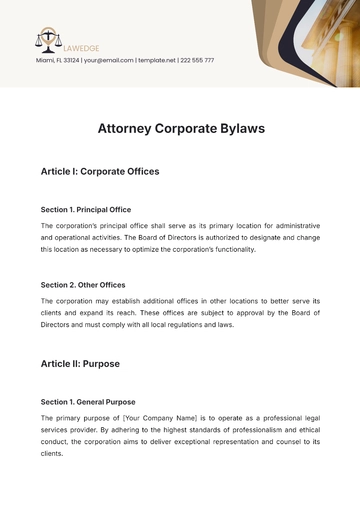Free Attorney Corporate Bylaws

Article I: Corporate Offices
Section 1. Principal Office
The corporation’s principal office shall serve as its primary location for administrative and operational activities. The Board of Directors is authorized to designate and change this location as necessary to optimize the corporation’s functionality.
Section 2. Other Offices
The corporation may establish additional offices in other locations to better serve its clients and expand its reach. These offices are subject to approval by the Board of Directors and must comply with all local regulations and laws.
Article II: Purpose
Section 1. General Purpose
The primary purpose of [Your Company Name] is to operate as a professional legal services provider. By adhering to the highest standards of professionalism and ethical conduct, the corporation aims to deliver exceptional representation and counsel to its clients.
Section 2. Specific Purpose
In addition to its core legal services, the corporation may engage in ancillary activities such as legal education, training, and consulting. These activities shall complement its primary mission and align with its commitment to serving the public interest.
Article III: Shareholders
Section 1. Meetings
Shareholders play a vital role in the governance of the corporation, and regular meetings provide a forum for discussion and decision-making. The annual meeting is mandatory and allows shareholders to elect directors and address significant issues. Special meetings are convened to address urgent matters or issues requiring immediate shareholder input. Proper notice ensures all shareholders have the opportunity to participate.
Section 2. Quorum
A quorum guarantees that decisions are made with sufficient representation from shareholders. By requiring a majority, the corporation ensures that its actions reflect the interests of most stakeholders.
Section 3. Voting Rights
Voting rights are fundamental to shareholder participation. By granting one vote per share, the corporation ensures that decisions are weighted according to the ownership stake of each shareholder.
Article IV: Board of Directors
Section 1. General Powers
The Board of Directors is the corporation’s central decision-making body, entrusted with overseeing its business operations and strategic direction. Directors are required to act in the corporation's best interests and exercise their powers with due care and diligence.
Section 2. Number, Election, and Term
The size of the Board ensures adequate representation while maintaining manageability. By allowing for amendments to the number of directors, the corporation can adapt to changing needs. Electing directors annually or for specified terms promotes accountability and ensures alignment with shareholder interests. Re-election allows shareholders to retain effective leaders.
Section 3. Meetings
Regular meetings facilitate ongoing oversight and enable the Board to address routine matters. The frequency of these meetings is designed to strike a balance between oversight and operational efficiency. Special meetings provide a mechanism for addressing unexpected or time-sensitive issues. Proper notice ensures transparency and preparedness.
Section 4. Quorum and Voting
A quorum ensures that Board decisions are made with adequate participation and representation. Requiring a majority vote promotes fairness and consensus among directors.
Article V: Officers
Section 1. Officers
The officers are responsible for executing the policies and directives established by the Board. Their specific roles and responsibilities are outlined to ensure accountability and clarity.
Section 2. Duties
The President serves as the face of the corporation and oversees its day-to-day operations. This role includes setting strategic priorities and ensuring organizational alignment with corporate goals.
The Vice President provides support and continuity in leadership, stepping in as necessary to maintain stability.
The Secretary plays a crucial role in ensuring compliance with corporate governance requirements by maintaining accurate records and communication.
The Treasurer safeguards the corporation’s financial health through careful management of funds, budgets, and financial reporting.
Article VI: Committees
Section 1. Establishment
Committees are essential for managing specialized tasks or projects that require focused expertise. Their formation and operation are governed by the Board to ensure alignment with corporate objectives.
Section 2. Composition
Committees must include at least one director to maintain a direct link to the Board. Additional members are selected based on their qualifications and the committee's specific needs.
Section 3. Authority
Committees operate under clear mandates that define their scope and authority. Significant actions or recommendations require Board approval to maintain oversight and accountability.
Article VII: Corporate Records
Section 1. Maintenance
Maintaining accurate records is critical for compliance, transparency, and efficient operations. These records include financial statements, meeting minutes, and legal documents.
Section 2. Inspection Rights
Granting shareholders and directors access to corporate records fosters transparency and trust. Inspection requests must be specific and reasonable to avoid disruption of business operations.
Article VIII: Amendments
Section 1. Amendment by Shareholders
Empowering shareholders to amend the bylaws ensures that the corporation remains aligned with their interests. A majority vote requirement balances shareholder input with practical governance.
Section 2. Amendment by the Board
The Board’s ability to amend the bylaws enables timely adjustments to address operational needs. However, certain fundamental changes remain the exclusive domain of the shareholders.
Article IX: Indemnification
Section 1. Indemnification of Directors and Officers
Indemnification provisions protect directors and officers from personal liability arising from their official duties, provided they act in good faith. These safeguards encourage capable individuals to serve in leadership roles without undue fear of litigation.
Section 2. Insurance
Liability insurance provides additional protection for directors, officers, and employees. This coverage ensures the corporation can attract and retain qualified individuals while minimizing financial risk.
Article X: Dissolution
Section 1. Voluntary Dissolution
The decision to dissolve the corporation requires the approval of both the Board and the shareholders. This process ensures that dissolution is deliberate and reflects the consensus of key stakeholders.
Section 2. Distribution of Assets
Upon dissolution, the corporation must satisfy all outstanding obligations to creditors before distributing remaining assets to shareholders. This process ensures fairness and compliance with legal requirements.
Certification
The undersigned Secretary certifies that these bylaws were duly adopted by the Board of Directors and shareholders on [Month Day, Year].
Signature:
 [Your Name]
[Your Name]
[Job Title]
[Your Company Name]
[Month Day, Year]
- 100% Customizable, free editor
- Access 1 Million+ Templates, photo’s & graphics
- Download or share as a template
- Click and replace photos, graphics, text, backgrounds
- Resize, crop, AI write & more
- Access advanced editor
Establish governance with the Attorney Corporate Bylaws Template from Template.net. Fully editable and customizable, this template is perfect for outlining a corporation’s rules, roles, and responsibilities. Use our AI Editor Tool to tailor it to your client’s specific needs. Its professional and precise format ensures clarity and adherence to legal standards.





























